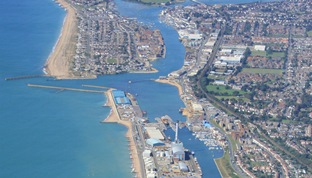Shoreham Harbour Heat Network
The Shoreham Harbour Heat Network is a part of the SmartHubs project, part funded by UK Research and Innovation, which will deploy a multi-scalar, multi-vector open-architecture smart local energy systems across heat, power & transport with interoperable Internet of Things layers as a blueprint for future local energy Smart Grids.
Although 2MW of heat from marine source heat pumps will be the backbone of a new district heat network, it is recognised that to achieve the UK's carbon targets "heat is only half of the problem".

The Electrification of Heat
The electrification of heat opens up opportunities not only to balance the national grid, but also to use demand side response techniques at the local level to balance local energy supply and demand.
The heart of the network is the efficient use of renewable energy based on the recycling of solar heat in the sea (transferred from the Caribbean by the Gulf Stream) to heat buildings on the network in winter.
Heat pumps are used to transfer heat to buildings in winter instead of generating heat afresh when needed by burning fossil fuels. ICAX has developed heat pumps which can deliver high temperatures so that they can be used at the heart of a Fourth Generation Heat Network to deliver heat to buildings on the network. ICAX is also researching the feasibility of using a Fifth Generation Heat Network in Shoreham.
Balancing the supply and demand for heat through the seasons is mirrored by balancing the supply and demand for electric power by shifting some of the demand from times of peak consumption (by day) to times of excess supply (by night).
Electrification of Transport
Vehicles can be free from emitting CO2 and NO2 if propulsion is based on an electric drive train. Battery electric vehicles need time to charge and electric charge points which will be installed in Shoreham. Fuel cell electric vehicles can be charged quickly at hydrogen charging points, which will also be installed at Shoreham and Horsham.
Virtual Power Plant
A Virtual Power Plant (VPP) will be installed to link generators and users of electricity, with smart controls and storage capacity to bridge the gaps between peak supply and peak demand.
Hundreds of homes, schools and council buildings will have solar panels, batteries and electic vehicles installed and linked together to demonstrate the advantages of smart technology which is designed to cut energy costs by 10%.

The SmartHubs Project brings together cross-sector supply chains to deliver integrated energy solutions at different scales to meet the energy systems challenges of achieving a low-carbon economy: secure, affordable, sustainable energy.
SmartHubs Consortium
The SmartHubs Consortium consists of:
- Connected Energy which will be installing recycled electric vehicle batteries to provide electrical storage services to help balance the local grid capacity.
- ICAX will provide 2MW of heat from the marine source heat pumps at the heart of the heat network and will design the abstraction and rejection systems for heat exchange with the Adur River in the tidal estuary.
- Moixa will create a Virtual Power Plant (VPP) to link solar panels, batteries and electric vehicles and use demand side management to balance the generation, storage and use of electricity including providing Vehicle to Grid (V2G) services to enable electric vehicles to be charged using off-peak electricity, and using electric batteries in EVs as a source of energy at times of peak demand.
- PassivSystems which will instal 250 air source heat pumps in existing housing association properties linked in to the existing gas replacement cycle to establish a significant electrical load that can be used to balance the local grid capacity.
- Mesh networks grid reinforcement will be installed to boost the local electrical infrastructure and increase its resilience by balancing supply and demand at the local substation level at the grid edge. This is designed to help move from the current pattern of radial network balancing toward a mesh balancing system which also allows balancing at the local level as well.
- ITM Power will be providing local hydrogen refuelling stations for electric vehicles. Its 'Power-to-Gas' stations use off peak electricity to generate hydrogen from electrolysis and store this for refuelling fuel cell electric vehicles (FCEVs) that use hydrogen fuel cells to produce electricity for their drive trains. Its refuelling stations will also provide electricity for battery electric vehicles (BEVs).
- Newcastle University which will be modelling simulations of the multiple energy vectors to be employed in the Smart Hubs Project, both individually and as an energy systems integration. The modelling will cover both energy efficiency and a full cost benefit analysis.
- West Sussex County Council which, in co-ordination with Adur and Worthing Councils, will establish a multi-vector local smart grid in Shoreham-by-Sea and develop a new procurement approach for smart grids that can be replicated elsewhere and be financeable.
Once deployed, these technologies will provide 7.65MW of generation and more than 17 MW of storage in a local smart grid at Shoreham.

The Energy Trilemma
The Smart Hubs Project is accepting the challenge from government and Innovate UK to resolve the Energy Policy Trilemma:
- by using heat networks,
- by using heat transfer instead of combustion,
- by accelerating the electrification of heat
- by accelerating the electrification of transport
- and by employing "demand response" to focus on using off-peak electricity and reduce peak electric demand.
Demand Response
Demand side response can be used to shift the timing of electric demand from hours of peak demand to times of surplus supply. DSR requires a bi-directional energy grid to signal when prices are low to trigger additional use (and to signal when prices are high to inhibit use).
Urban Air Quality
ICAX is also addressing the growing problem of air pollution: the marine source heat pumps and air source heat pumps will provide heating without employing combustion or releasing any gasses on site.
Electrification of Heat
The Shoreham Harbour Heat Network will provide heating to many buildings in Shoreham by heat transfer from the sea. Gas CHP may also be used to generate heat within the local smart grid and power for use locally, both for heating and for transport.
See Ground Source Heating See Ground Source Cooling See Ground Source Energy





